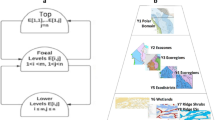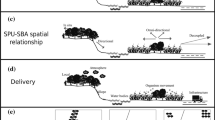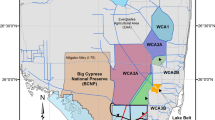Abstract
The present purpose is to provide convenient computational capability and visualizations for preliminary partial or progressive prioritization based largely on concepts of partial order theory and implemented in R software as illustrated in a context of conservation and sustainable stewardship across landscapes with ecosystem services as a complex multidimensional domain that must be placed in public and private perspective in pursuit of multi-resource management. Practical perspective is promoted by graphic visualization with local partial order modeling (LPOM) methods for screening of settings and scenarios involving interactions of ecosystem elements as evidenced by environmental indicators. ORDIT ordering and precedence plots arise from ascribed advantage as an outcome of a rating regime. Representative ranks constitute criteria drawn from the rank distribution for the case in question. Distal data are determined with regard to remediation and retention. Median mismatches reflect interplay of indicators appearing as isolated instances in plotting patterns. A suggested strategy to circumvent computational constraints is partitioning the pool of cases into collectives by clustering, pursuing classes of partitions, and then prioritizing in particular partitions. When prime prospects have been obtained, detailed determinations can be done with partial ordering procedures involving Hasse diagrams and similarly complex constructs that are difficult to apply with many cases and/or indicator criteria.
Similar content being viewed by others
References
Alvarez M, Field D (2009) Tradeoffs among ecosystem benefits: an analysis framework in the evaluation of forest management alternatives. J For 107: 188–196
Bruggemann R, Sorensen P, Lerche D, Carlsen L (2004) Estimation of averaged ranks by a local partial order model. J Chem Inf Comp Sc 44: 618–625
Bruggemann R, Simon U, Mey S (2005) Estimation of averaged ranks by extended local partial order models. MATCH Commun Math Comput Chem 54: 489–518
Bruggemann R, Voigt K (2008) Basic principles of Hasse diagram technique in chemistry. Comb Chem High Throughput Screen 11: 756–769
Bruggemann R, Patil GP (2010) Ranking and prioritization with multi-indicator systems. Technical Report No. 2010–0331 (Draft Monograph), Center for Statistical Ecology and Environmental Statistics, Dept. of Statistics: The Pennsylvania State University, Univ. Park, PA, 16802, USA
Bruggemann R, Patil GP Multicriteria prioritization and partial order in environmental sciences. Environ Ecol Stat 17
De Loof K, De Meyer H, De Baets B (2006) Exploiting the lattice of ideals representation of a poset. Fundam Informaticae 71: 309–321
De Loof K, De Baets B, De Meyer H, Bruggemann RA (2008) hitchhiker’s guide to poset ranking. Comb Chem High Throughput Screen 11: 734–744
Miller D, Wigley T, Miller K (2009) Managed forests and conservation of terrestrial biodiversity in the southern United States. J For 107: 197–203
Myers W, Bishop J, Brooks R, O’Connell T, Argent D, Storm G, Stauffer J Jr (2000) The Pennsylvania GAP Analysis Final Report; The Pennsylvania State University, Univ. Park, PA, USA
Myers W, Patil GP (2006) Biodiversity in the age of ecological indicators. Acta Biotheo 54: 119–123
Myers W, Patil GP, Cai Y (2006) Exploring patterns of habitat diversity across landscapes using partial ordering. In: Bruggemann R, Carlsen L (eds) Partial order in environmental sciences and chemistry. Springer, Berlin, pp 309–325
Newlin J, Myers W, Patil GP, Joshi S (2010) Improving transparency of bridge condition for decision-making and analysis in bridge management. In: Frangopool D, Sause R, Kusko C (eds) Bridge maintenance, safety, management and life-cycle optimization. Taylor and Francis Group, London, pp 3409–3414
Patil GP, Taillie C (2004) Multiple indicators, partially ordered sets, and linear extensions : multi-criterion ranking and prioritization. Environ Ecol Stat 11: 199–228
Patil GP, Myers W (2008) Digital governance and hotspot geoinformatics of biodiversity measurement, comparison and management in the age of indicators and information technology; Technical Report No. 2008–1121, Center for Statistical Ecology and Environmental Statistics, Dept. of Statistics: The Pennsylvania State University, Univ. Park, PA, 16802, USA
Venables W, Smith D (2004) An Introduction to R, revised and updated. Network Theory Limited, Bristol
Author information
Authors and Affiliations
Corresponding author
Additional information
This material is based upon work partially supported by the National Science Foundation under Grant No. 0307010. Any opinions, findings, and conclusions or recommendations expressed in this material are those of the authors and do not necessarily reflect the views of agencies.
Rights and permissions
About this article
Cite this article
Myers, W., Patil, G. Preliminary prioritization based on partial order theory and R software for compositional complexes in landscape ecology, with applications to restoration, remediation, and enhancement. Environ Ecol Stat 17, 411–436 (2010). https://doi.org/10.1007/s10651-010-0160-x
Received:
Revised:
Published:
Issue Date:
DOI: https://doi.org/10.1007/s10651-010-0160-x




